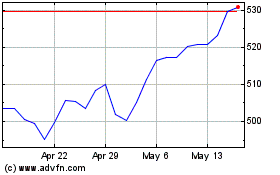What Next for S&P 500 After 13.8% Gain In First Half of 2023?
27 June 2023 - 9:07PM
Finscreener.org
WeU+02019re approaching a
significant milestone next week - the concluding trading week of
not just the month and quarter, but also the first half of 2023.
The
S&P 500 has shown
a stellar performance, boasting an increase of 13.8% so far this
year.
Delving into history, when the
S&P 500 has ascended by at least 10% by the end of June, it
has climbed higher 82% of the time by year-end, averaging an
additional gain of 7.7%. These statistics come courtesy of research
conducted by the Carson Group.
Interest rate hikes might lead to corporate
defaults
The Federal ReserveU+02019s
commitment to raising interest rates to curb inflation could
trigger a surge in corporate default rates in the upcoming months.
In May, the corporate default rate climbed, highlighting the
challenges that U.S. companies face in dealing with rising interest
rates, which complicate debt refinancing and pose an uncertain
economic future.
A striking 41 defaults have
occurred in the U.S., along with one in Canada this year, marking
the highest in any global region and over double compared to the
same timeframe in 2022, as per Moody’s Investors
Service.
Federal Reserve Chairman Jerome
Powell recently suggested more interest rate hikes are on the
horizon this year, although at a subdued pace until significant
strides are made to curb inflation.
Financial experts point to high
interest rates as the primary stress inducers. Companies requiring
liquidity or those burdened with significant debt and in need of
refinancing face an escalated cost of new debt.
Distressed exchanges often emerge
as a go-to solution. This involves companies exchanging their debt
for a different form of debt or repurchasing the debt. In extreme
cases, restructuring in or outside court becomes
necessary.
In an interview with CNBC, Mohsin
Meghji, founding partner of M3 Partners, illustrates the point of
higher debt costs by citing how average financing rates of 4% to 6%
over the past 15 years have now soared to 9% to 13%.
Despite recently affected
companies
being the most troubled, Meghji predicts that even financially
stable firms will face refinancing issues due to high interest
rates.
As of June 22, 324 bankruptcy
filings were reported, nearing the 374 total in 2022, according to
S&P Global Market Intelligence. Over 230 bankruptcy filings
occurred by April this year, marking the highest rate since
2010.
The most substantial default in
May was Envision Healthcare, an emergency medical services provider
with over $7 billion in debt at the time of filing for bankruptcy,
according to Moody’s (NYSE:
MCO). Other notable
bankruptcy filings this year include Monitronics International,
Silicon Valley Bank, Bed Bath & Beyond, and Diamond
Sports.
Moody’s projects the global
default rate to escalate to 4.6% by yearU+02019s end, surpassing
the long-term average of 4.1%, and to peak at 5% by April 2024
before beginning to decrease.
U.S. Home Price Overview
On Tuesday, we expect fresh
updates on U.S. home prices via the Case-Shiller Home Price Index
and the Federal Housing Finance Agency’s (FHFA) House Price Index
for April. The Case-Shiller Index likely shows a 0.8% rise in home
prices in April, recovering from a 1.5% increase in March. However,
these values probably represent a 1.5% decrease on a year-over-year
basis.
March witnessed the first annual
fall in prices since the early days of 2012, a stark contrast to
the record-high growth rates observed a year earlier before the
Federal ReserveU+02019s interest rate hikes began influencing
housing demand.
FedU+02019s Favored Inflation Indicator
On Friday, the Bureau of Economic
Analysis (BEA) will release the Personal Consumption Expenditures
(PCE) Price Index, the FedU+02019s favored inflation measure, for
May. The prediction is that prices rose by 0.2% last month,
following a 0.4% increase in April. The annual rise is likely to be
4.1%, a deceleration from AprilU+02019s 4.4%.
Core PCE prices, which omit the
unstable food and energy costs, likely increased 4.5% year-on-year,
slowing from the 4.7% pace observed in April. ItU+02019s worth
noting that the Federal Reserve aims for a 2% annual PCE inflation
rate as a part of its dual mandate to achieve price stability and
full employment.
SPDR S&P 500 (AMEX:SPY)
Historical Stock Chart
From Jan 2025 to Feb 2025

SPDR S&P 500 (AMEX:SPY)
Historical Stock Chart
From Feb 2024 to Feb 2025
